In 1971 Folkman proposed that tumour growth was dependent upon angiogenesis, and consequently suggested that preventing angiogenesis might prevent tumour growth.1 This concept led to research into manipulating angiogenesis in order to influence tumour progression, and subsequently other therapeutic areas, including cardiology and ophthalmology. In 1983 vascular permeability factor (VPF) was discovered, followed by vascular endothelial growth factor (VEGF) in 1989. It later transpired that they were in fact the same molecule.
Effect of VEGF on the vasculature
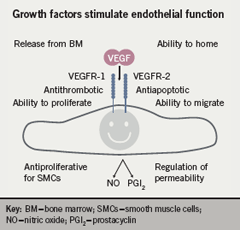
VEGF plays a primarily protective role in the vasculature (figure 1).2 It is known that VEGF stimulation of the endothelium has an antithrombotic effect. It stimulates endothelial cells to proliferate and migrate, which is crucial for the renewal of the endothelium. VEGF also has an anti-apoptotic effect, allowing endothelial cells to survive for longer periods of time. VEGF stimulation of endothelial cells is involved in the induction and release of nitric oxide and prostacyclin, enabling the endothelial cells to interact with other cells.3,4 Furthermore, VEGF has an antiproliferative effect on smooth muscle cells and regulates vessel wall permeability.5 It is therefore clear that inhibition of VEGF is likely to have unwanted effects on the vasculature: it would be prothrombotic, pro-apoptotic and vasoconstrictive.
Endothelial cells have a major role in angiogenesis. However, circulating monocytes also carry VEGF receptors and contribute to the formation of collateral vessels. In the heart and peripheral circulation, collateral vessels are protective, for example by providing additional tissue perfusion in the presence of blood vessel blockage. Indeed, VEGF stimulation can be used therapeutically to promote the growth of collateral vessels.6 If the femoral artery of a mouse is ligated (to induce claudication), perfusion can be significantly increased following the intravenous application of VEGF for seven days.7 Furthermore, this elevated perfusion appears to be largely mediated via VEGF receptor 1 (VEGFR-1), which is present on the surface of both endothelial cells as well as circulating monocytes.
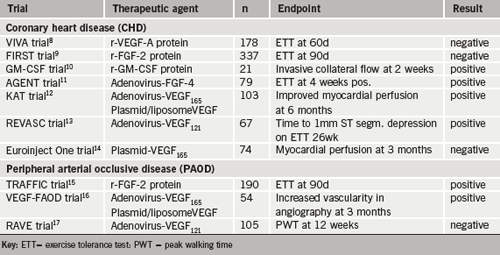
A number of phase II and III trials of therapeutic angiogenesis have been conducted, many using VEGF receptor-stimulating agents, but with mixed results (table 1).8-17 Consequently, there is no currently accepted pro-VEGF therapy with proven efficacy in the clinical situation. It is thought that a reason for treatment failure may have been the relatively short timeframe of VEGF application: in order for VEGF to exert a biological effect on collateral vessel growth, it needs to be present for at least one week in sufficient concentrations. All the therapies trialled so far have resulted in only a short spike in VEGF concentration. With improvement of the duration of VEGF receptor stimulation, better results might be seen.
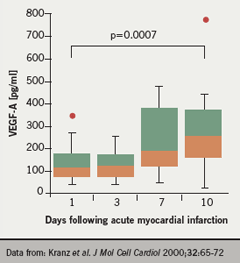
In the presence of ischaemia, VEGF levels rise, suggesting that hypoxia stimulates the VEGF system (figure 2).18 However, VEGF also appears to be present in non-ischaemic tissue, suggesting that a baseline level of VEGF is required to maintain normal vascular function. Reduction in this baseline level of VEGF is likely to result in adverse effects on the circulatory system.
There are a number of different strategies that can be utilised to inhibit VEGF signalling. These include: anti-VEGF antibodies, soluble VEGF receptors, aptamers, VEGF receptor antibodies and inhibitors of the VEGF receptor signalling pathway (tyrosine kinase inhibitors).19,20
Effects of VEGF on the lung
VEGF inhibition has been used for the treatment of various cancers.21 An interesting finding from the treatment of lung cancer is that a baseline level of VEGF activity appears to be required for the maintenance of normal lung function. Following the introduction of a VEGF receptor-inhibiting agent, lung cell apoptosis has been seen to occur.22 Thus, inhibition of VEGF could lead to emphysema and lung destruction.
Effects of VEGF on atherosclerosis
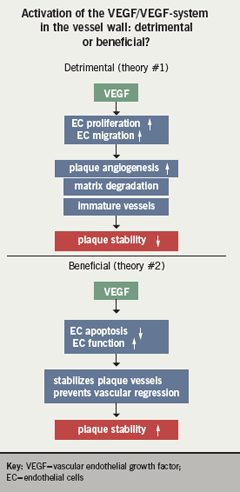
A number of factors are known to be present within atherosclerotic plaques that stimulate the development and growth of plaques. Among these is VEGF. It has been proposed that, in the atherosclerotic plaque, VEGF stimulates endothelial proliferation and migration, leading to an increase in plaque angiogenesis, matrix degradation and immature vessels and resulting in plaque instability. In turn, plaque instability can lead to thrombotic events, including myocardial infarction and ischaemic stroke. However, it is also possible that VEGF could provide an increase in plaque stability by decreasing endothelial cell apoptosis and improving endothelial cell function, resulting in the prevention of vascular regression (figure 3).
In trials where VEGF was added to atherosclerotic plaques, no evidence for further progression of the plaque or evidence of increased instability has been observed.23-25 However, extrapolation from oncological findings predicts that inhibiting VEGF would result in capillary regression, capillary thrombosis and intraplaque necrosis (figure 4). This would lead to an increase in thrombotic events in those receiving VEGF-inhibiting therapy.
The age-related macular degeneration population
Coronary atherosclerosis is a frequent finding in the elderly population, and the risk of coronary atherosclerosis rises with age. The one-day mortality of acute myocardial infarction is around 35%.26 The one-year mortality of patients above 75 years of age with ST-elevation myocardial infarction (STEMI) is 52.4% for conservative treatment and 19.2% for primary percutaneous intervention.27
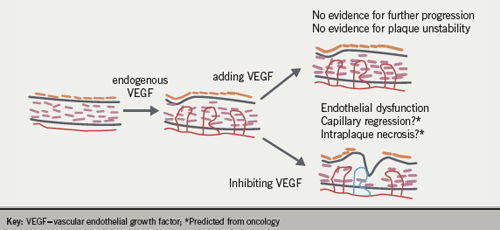
At the time of diagnosis of age-related macular degeneration (AMD), the average patient is 75 years of age, with a life expectancy of 11.8 years.28,29 Neovascular AMD (wet AMD) is often associated with significant co-morbidities, such as diabetes and cardiovascular disease.30 Wet AMD may be treated with VEGF inhibitors, which, although administered intravitreally, are absorbed systemically and thus could potentially have systemic effects.
Summary
Angiogenic growth factors are important functional stimuli for vascular cells. As well as stimulating angiogenesis, they are involved in maintenance of the integrity of the vasculature. Inhibition of angiogenic growth factors efficiently inhibits tumour angiogenesis and reduces tumour growth. However, inhibition of angiogenic growth factors may lead to vascular dysfunction and vascular complications such as atherosclerotic plaque rupture and acute ischaemic syndromes.
This should be an important consideration when administering VEGF-inhibiting treatment for wet AMD, in a population that is already at high risk for cardiovascular events.
Conflict of interest
Professor Waltenberger is an advisor to Pfizer.
References
- Folkman J. Tumor angiogenesis: therapeutic implications. N Engl J Med 1971;285:1182–6.
- Kliche S, Waltenberger J. VEGF receptor signalling and endothelial function. IUBMB Life 2001;52:61–6.
- Kroll J, Waltenberger J. A novel function of VEGF receptor-2 (KDR): rapid release of nitric oxide in response to VEGF-A stimulation in endothelial cells. Biochem Biophys Res Commun 1999;265:636–9.
- Zachary I, Mathur A, Yla-Herttuala S, Martin J. Vascular protection: a novel nonangiogenic cardiovascular role for vascular endothelial growth factor. Arterioscler Thromb Vasc Biol 2000;20:1512–20.
- Becker PM, Waltenberger J, Yachechko R et al. Neuropilin-1 regulates vascular endothelial growth factor-mediated endothelial permeability. Circ Res 2005; 96:1257–65.
- Babiak A, Schumm AM, Wangler C et al. Coordinated activation of VEGFR-1 and VEGFR-2 is a potent arterigenic stimulus leading to enhancement of regional perfusion. Cardiovasc Res 2004;61:789–95.
- Tsurumi Y, Takeshita S, Chen D et al. Direct intravascular gene transfer of naked DNA encoding vascular endothelial growth factor augments collateral development and tissue perfusion. Circulation 1996; 94:3281–90.
- Henry TD, Annex BH, Azrin MA et al. Double-blind, placebo-controlled trial of recombinant human vascular endothelial growth factor: the VIVA trial. J Am Coll Cardiol 1999; 33:384A.
- Simons M, Annex BH, Laham RJ et al. Pharmacological treatment of coronary artery disease with recombinant fibroblast growth factor: double-blind, randomised, controlled clinical trial. Circulation 2002; 105:788–93.
- Seiler G. Promotion of collateral growth by granulocyte-macrophage colony stimulating factor in patients with coronary artery disease. Circulation 2001;104: 2012–17.
- Grimes CL. Angiogenic Gene Therapy (AGENT) in patients with stable angina pectoris. Circulation 2002; 105:1291–7.
- Hedman M. Safety and feasibility of catheter-based local intracoronary VEGF gene transfer in the prevention of post-angioplasty and in-stent restenosis and in the treatment of chronic myocardial ischaemia. The Kuopip angiogenesis trial (KAT). Circulation (in press).
- Stewart DJ A phase 2, randomised, multicentre, 26-week study to assess the efficacy and safety of BIOBYPASS (AdGVVEGF121) delivered through minimally invasive surgery versus maximum medical treatment in patients with severe angina, advanced coronary artery disease and no options for revascularisation. Circulation 2002;106: 23–6.
- Kastrup J. Euroinject One trial. Late breaking clinical trials session. American College of Cardiology 2003, Chicago. J Am Coll Cardiol 2003; 41:1604.
- Lederman RJ. Therapeutic angiogenesis with recombinant fibroblast growth factor-2 for intermittent claudication (the TRAFFIC study): a randomised trial. Lancet 2002;359: 2053–8.
- Makinen K. Increased vascularity detected by digital subtraction angiography after VEGF gene transfer to human lower limb artery. Mol Ther 2002; 6:127–33.
- Rajagopalan S. Regional angiogenesis with vascular endothelial growth factor in peripheral arterial disease (RAVE). Late breaking clinical trials session. American College of Cardiology 2003, Chicago. J Am Coll Cardiol 2003;41:1604.
- Kranz A, Rau C, Kochs M, Waltenberger J. Elevation of vascular endothelial growth factor-A serum levels following acute myocardial infarction. Evidence for its origin and functional significance. J Mol Cell Cardiol 20 00;32:65–72.
- Ferrara N, Kerbel RS. Angiogenesis as a therapeutic target. Nature 2005;438:967–74.
- Moreira IS, Fernandes PA, Ramos MJ. Vascular endothelial growth factor inhibition—a critical review. Anticancer Med Chem 2007; 7: 223–45.
- Ferrara N. Vascular endothelial growth factor: basic science and clinical progress. Endocr Rev 2004; 25: 581–611.
- Kasahara Y, Tuder RA, Taraseviciene-Stewart L et al. Inhibition of VEGF receptors causes lung cell apoptosis and emphysema. J Clin Invest 2000;106:1311–19.
- Lucerna M, Zernecke A, de Nooijer R et al. Vascular endothelial growth factor-A induces plaque expansion in ApoE knock-out mice by promoting de novo leukocyte recruitment. Blood 2007;109:122–9.
- Dunmore BJ, McCarthy MJ, Naylor AR, Brindle NP. Carotid plaque instability and ischemic symptoms are linked to immaturity of microvessels within plaques. J Vasc Surg 2007;45:155–9.
- Petrovan RJ, Kaplan CD, Reisfeld RA, Curtiss LK. DNA vaccination against VEGF receptor-2 reduces atherosclerosis in LDL receptor-deficient mice. Arterioscler Thromb Vasc Biol 2007;27:1095–100.
- Löwel H, Meisinger C. [Epidemiology and demographic evolution exemplified for cardiovascular diseases in Germany]. Med Klin (Munich) 2006;101:804–11.
- Zeymer U, Gitt A, Winkler R et al. [Mortality of patients who are older than 75 years after ST elevation myocardial infarction in clinical practice]. Dtsch Med Wochenschr 2005;130:633–6.
- Zlateva GP, Javitt JC, Shah S et al. Comparison of comorbid conditions between neovascular age-related macular degeneration patients and a control cohort in the Medicare population. Retina 2007;27:1292–9.
- van Wijngaarden P, Coster DJ, Williams KA. Inhibitors of ocular neovascularization: promises and potential problems. JAMA 2005;293:1509–13.
- Hyman L, Schachat AP, He Q, Leske MC, for the Age-Related Macular Degeneration Risk Factors Study Group. Hypertension, cardiovascular disease, and age-related macular degeneration. Arch Ophthalmol 2000;118:351–8.
